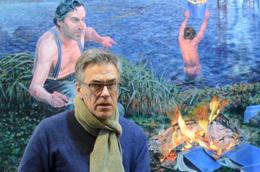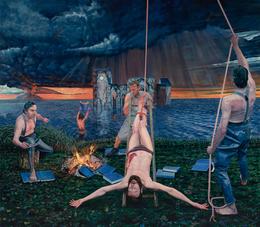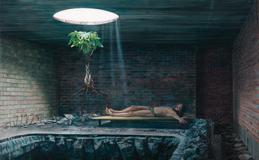Painter of the North, Painter of the South
In this text describes the ar-historian Prof. Dr. Michael Scholz-Haensel the painting of St. Bartholomew by Aris Kalaizis under inclusion of art-historical aspects. Furthermore he sees in the painter a personified merger of the northern and southern hemisphere

It may indeed seem strange, when a agnostic painter suddenly works with religious material. Although, of course, we should note that it is by no means surprising, as secular-minded artists have always embarked on excursions into the realm of religious matter. We may, furthermore, even ask if religiosity hadn’t hitherto been all too naturally associated with explicit declarations of faith or a belief in God, and if striving towards transcendence or looking for some sort of meaning in a supposed afterlife isn’t really something inherently human. During an interview, Michel Houellebecq recently said to the German weekly newspaper ›DIE ZEIT‹ that »a society without religion isn’t capable of surviging. Laicism, critical rationalism, and the Enlightenment, whose basic premise demands a departure from religious ideas, is without a future«.
…the church ruins in the sea
Son of Greek political immigrants in the GDR, Aris Kalaizis was born in Leipzig in 1966. Like Neo Rauch, who is just eight years older, Aris Kalaizis studied under Arno Rink at the renowned Academy of Visual Arts Leipzig (Hochschule für Grafik und Buchkunst). Each of the three paints, just mentioned, belong to a movement dedicated to a new approach to figurative painting known as the ›New Leipzig School‹. They hold in common a meticulous display of technical brilliance and the reanimation of Renaissance-like linear perspective that had originally been rejected by the avant-garde working around 1900.
But the classical rivalry, the paragone, challenging the Old Masters is only one aspect of Kalaizis' artistry. His paintings rather gain their enormous energy from their political urgency and their ability to build a bridge to modernity, for instance, by including modern technologies and by their affinity to Conceptual Art as it will become evident when considering the process from which the paintings emerge.

The recently completed painting ›The Martyrdom of Saint Bartholomew or the double Martyrdom‹ (2014÷2015) will be the focal point of our attention. With its dimensions stretching 98 x 112 inches, it is truly a monumental piece of art. In painting the new retired Pope Benedict XVI. in 2009, Aris Kalaizis had already touched upon sacred matter for his narrative composition ›make/believe‹ to which he added a critical spin. And now a ›Saint Bartholomew‹ followed his depiction of the pontiff, and it now merges iconic religious traditions of northern and southern Europe in an astonishing way.
The Christian martyr is the patron saint of Frankfurt am Main and its principal religious edifice, the Imperial Cathedral, is dedicated to Saint Bartholomew. Until August 2015, visitors to the Cathedral may take a look at that painting and discuss questions related to its unique composition. The religious topic is framed by an enormous landscape panorama, which has been divided into three equal zones that correlate in terms of form and content. The foreground is constituted by a green coastal strip, upon which the figurative scene takes place. It is followed by a body of water that is marked off by a thin red line along the horizon and centers around church ruins. But suspended above the entire composition, we see a gloomy cloudy sky. Relatively cold colors dominate the painting. They are merely counterbalanced by specs of red and the blazing batches belonging to a bonfire in which books are being burned.
At the center of the green plateau, we are shown the flaying of St. Bartholomew. During his missionary work in Armenia, legend has it that he was flayed by heathen henchmen and later was beheaded in India. But Aris Kalaizis consciously chose a composition that is reminiscent of St. Peter's crucifixion. The apostle and founder of the papal church did not deem himself equal to Christ and therefore demanded to be crucified upside down.
…to imagine a straight line that connects his feet with those of the man standing on the right side
The painter has subsumed the saint and his three tormentors in an artful composition. The male figure in a sitting posture on the left hand side not only guides us and opens the pictorial space towards the right but also allows us to imagine a straight line that connects his feet with those of the man standing on the right side. We are looking at two figures that have been modelled off the same person who posed for the painting. If we now imagine a second axis that projects from the left figure's head to the arm of the figure to the right, we may clearly realize how the entire composition is geometrically framed by a conic form.
In addition to the axial points of reference in the painting, the blue books strewn across the foreground, resembling the gospel spread by Bartholomew, connect the figurative agents. Turning to comparing the left and right halves of the painting, we quickly realize a certain disproportionality. While the right side of the painting is partitioned off by the rope hanging down from the upper frame, it at the same time leaves open a space for reflection. The left hand side, on the other hand, offers multiple motifs – the fire, a volcano at the horizon, and a male figure standing in the shallow costal water and holding up a burning book. That figure may be of significant importance in interpreting the painting, as the sitting figure, who is holding a knife and – as we know – guides the beholder towards the scene on the right to him, is also pointing at the man in the water.
In iconographical terms, the painting marks a dramatic turning point with an open, undecided ending. The gloomy and agitated sky is reminiscent of apocalyptic scenes as they have dominated the silver screen in recent years. Some may immediately recall Lars von Trier's ›Melancholia‹ (2011). Saint Bartholomew, however, is in a long tradition that was founded by Michelangelo who has secured his self-portrait on the skin of the martyr within the ›Last Judgment‹ in the Sistine Chapel. But for Aris Kalaizis, interpretations of the subject by Jusepe de Ribera may be more important than this Roman model. Ribera emphasized the temporal and ultimately more brutal character of the martyrdom, by rejecting features in typical depictions of his time in which the martyrdom was rewarded by angels crowning the saint. The church ruins in the sea, of course, invoke the Romantic tradition of, for example, Caspar David Friedrich. Both painters seem to be united, despite the centuries separating them, in their pessimistic view of history in which churches no longer are magnificent structures but instead deserted places. There still may be paths leading up to them, but the flood has made them indecipherable. But critical reflection may still be able to access these ecclesiastical spaces.
…like the angel in ›make/believe‹ he is calling for a return to the powers unseen, for repentance
It is conceivable that the unusual choice of a body of water hinges on a regional antecedent, namely the various villages that vanished during the days of excessive coal mining in the close vicinity of Leipzig. These mining pits have later been flooded and turned into lake landscapes that are supposed to attract tourists. Supporting this interpretation is the choice that Kalaizis made regarding the model for the church ruin, which corresponds to an actual church ruin in a village called Wachau near Leipzig.
Viewed in this way, the figure placed into the water holding up a burning book makes sense. Like the angel in ›make/believe‹ he is calling for a return to the powers unseen, for repentance. The warm red tones in his skin are in opposition to the pale skin and cold blue tones used in the other figures. He definitely does not belong to them or at least is unlike them. As indicated by the picture's title, there are other martyrdoms behind the obvious martyrdom that takes place in the foreground of the scene – there is a secondary, ›double‹ sense of martyrdom in the painting. »He who burns books will also burn human beings«, Heinrich Heine once wrote, but it was also the inquisition that once burnt books, in order to test their orthodoxy (which would supposedly protect the books from catching fire). Does this imply, contrary to the Roman Catholic view, Luther's ›sola scriptura‹? Obviously the possible ways of looking at this painting get a bit more complicated at this point.

These recent ›sacred‹ paintings by Aris Kalaizis came about long before the terror attacks in Paris once again stirred up a debate on the role and meaning of religion in modern societies. In my view, we are confronted with a general trend that is reflected in the rather traditional portraits of Pope Benedict XVI by Michael Triegel, the church window artwork by Gerhard Richter, Markus Lüpertz, Neo Rauch and others, but also in the freely invented portraits of saints by street art artists.
But unlike Michael Triegel who recently converted to Catholicism, the atheist Aris Kalaizis has maintained a critical stance towards religion that is similar to the attitude displayed by the protagonist in Michel Houellebecq's novel ›Submission‹ (2015) that was published after the painting had been completed. In Houellebecq's story, the protagonist enters a cloister and thereby consciously emulates Joris-Karl Huysmans, in order to reject that lifestyle and to live a profane alternative that is full of self-irony.
…neither the Protestant art of northern Europe (e.g. Caspar David Friedrich) nor the Catholic alternatives in southern Europe (e.g. Michelangelo, Ribera etc.) will lead us out of the current crisis that isn’t just created by pressing economic questions, but is also a spiritual crisis
Aris Kalaizis, of course, is aware that his conceptual painting will not lead anybody back onto the path of faith, and his intention is by no means offering a return to the roots of occidental civilization. Christianity lay in ruins and has failed to draw meaningful conclusions from its inherent violence. This is what we are shown here. Neither the Protestant art of northern Europe (e.g. Caspar David Friedrich) nor the Catholic alternatives in southern Europe (e.g. Michelangelo, Ribera etc.) will lead us out of the current crisis that isn’t just created by pressing economic questions, but is also a spiritual crisis.
It is therefore no surprise that there are less similarities between the work of Aris Kalaizis and his New Leipzig School competitor Michael Triegel and more similarities between Aris Kalaizis and Gregory Crewdson who currently is one of the most successful proponents of staged photography. There is a lot of overlap with regard to the mood and atmosphere, but also with regard to the process that brings about a picture. Both artists work in multiple steps and make use of the medium photography, in order to generate space for reflection. Aris Kalaizis initially choses specific locations – this may be an abandoned building in the vicinity of Leipzig or a fully constructed scene in his atelier. At this location, Aris Kalaizis then brings together the various models and objects that he plans to depict in the painting. Having devised an artful staging, in which lighting is as central an element as in the work of Crewdson, Aris Kalaizis then enters a process of complex and tedious photographic documentation. This gives photographic images that he may use when finalizing the composition in his atelier, before he begins painting the picture onto the canvas.
Kalaizis and Crewdson offer the spectator an augmented sense of reality that opens up space for phantasy and speculation – that is, it opens up a space that most artists seek to eliminate by offering more and more concise and unambiguous arrangements. With Aris Kalaizis' approach in view, the American art historian Carol Strickland invented the term ›Sottorealism‹. But the religious paintings by Aris Kalaizis go one step further. On the one hand, they accuse traditional religious establishments of having lost any sense of spirituality; on the other hand, they offer an iconic vocabulary of Christian imagery that seems to be increasingly vanishing from our collective memory. This then is tied to the demand that we are ought to finally put new life into these things, now. In order to open up this philosophical discourse, the painter cites two seemingly antagonist traditions, the northern European tradition of Romanticism and the southern European tradition of Baroque painting as exemplified by Ribera and El Greco. This is a wonderful offer, especially when considering the current struggle for European unity.
Translated by Paul-Henri Campbell
Prof. Dr. Michael Scholz-Hänsel was born in 1955 and is professor for art history at the University of Leipzig. His research is concentrated on Ibero-American art. In addition to monographs on El Greco and Jusepe de Ribera, he published »Inquisition und Kunst ›Convivencia‹ in Zeiten der Intoleranz« (2009) and was co-editor of »Armut in der Kunst der Moderne« (2011) as well as »El Greco und die Moderne« (2012).
©2014 Michael Scholz-Haensel | Aris Kalaizis